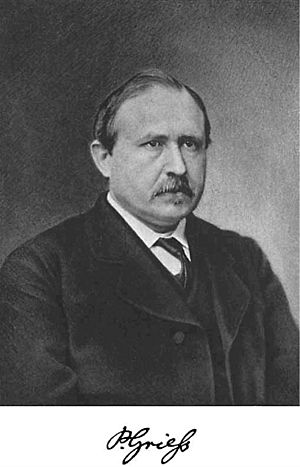Peter Griess facts for kids
Quick facts for kids
Johann Peter Griess
|
|
|---|---|
 |
|
| Born | 6 September 1829 Kirchhosbach (now part of Waldkappel), Germany
|
| Died | 30 August 1888 (aged 58) |
| Nationality | German |
| Alma mater | University of Marburg |
| Known for | diazotization reaction |
| Scientific career | |
| Fields | Chemist |
| Institutions | University of Marburg Royal College of Chemistry |
| Doctoral advisor | Hermann Kolbe, August Wilhelm von Hofmann |
Johann Peter Griess (born September 6, 1829 – died August 30, 1888) was an important chemist. He helped create many modern dyes. He is famous for discovering the "diazotization reaction," which is a special way to make new chemical compounds. This discovery was a big step forward in organic chemistry, which is the study of carbon-based chemicals.
Contents
The Life of Johann Peter Griess
Johann Peter Griess was born in Germany in 1829. After finishing school, he briefly joined the army. He then decided to study at the University of Jena in 1850. A year later, he moved to the University of Marburg.
Student Life and Early Career
During his time as a student, Griess sometimes got into trouble. He was even sent to the "Karzer," which was like a campus jail. He was also banned from the city for a year. During this time, he attended lectures by another famous chemist, Justus Liebig.
By 1856, his family had spent a lot of money on his education. Griess needed to find work. He started at a chemical factory in Offenbach am Main. This was possible because Hermann Kolbe, who was a chemistry professor at Marburg, recommended him.
A Big Discovery
In 1857, a fire destroyed the factory where Griess worked. He then returned to the University of Marburg and worked with Hermann Kolbe again. His passion for chemistry grew stronger. In 1858, he made a very important discovery: he found a new group of chemicals called "diazonium salts."
This discovery impressed another leading chemist, August Wilhelm von Hofmann. Hofmann invited Griess to join him at the Royal College of Chemistry in England. Griess moved to England and began studying organic molecules that contain a lot of nitrogen.
Life in England
It took Griess some time to get used to living in England. However, he married in 1869 and started a family there. This showed that he planned to stay in England. He even turned down a job offer from a big German chemical company called BASF.
In 1862, Griess started working at the Samuel Allsopp & Sons brewery. He worked there until he retired. His wife passed away in 1886 after a long illness. Johann Peter Griess died two years later, on August 30, 1888. He is buried in Burton upon Trent, England.
Griess's Important Work in Chemistry
Johann Peter Griess is best known for his discovery in 1858. He described the Griess diazotization reaction. This reaction became very important for creating many modern dyes. It also formed the basis for the Griess test. This test is still used today to find tiny amounts of Nitrite in different substances.
While much of his work at the brewery remained private, Griess published many articles about his other discoveries in organic chemistry. His work helped shape the way chemists understand and create new compounds.

